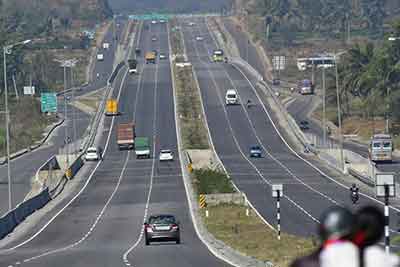Date: 10/02/2023
Relevance: GS-2: Government Policies and Interventions for Development in various sectors and Issues arising out of their Design and Implementation.
Relevance: GS-3: Infrastructure: Transport- Road, Air, Water, Rail etc.
Key Phrases: Infrastructure, Infrastructure Finance Secretariat, GST E-way Bill, Big Data, UDAN Scheme, Highway authority of India, Airport, National Highways, Projection of Traffic Volume.
Context:
- The successive Budgets of the NDA government have emphasized on
increased investments to upgrade infrastructure.
- Among the infrastructure segments, investment in transport corridors (land, water, rail, air) has been the focal theme of the government for successive years.
Key Highlights:
- India’s domestic aviation market is led by low-cost carriers that control as much as 80 percent of the market, led by market leader IndiGo which corners nearly 60 percent.
- The newly-established Infrastructure Finance Secretariat will be key to assisting all stakeholders with more private investment in infrastructure, including railways, roads, urban infrastructure and power, which are predominantly dependent on public resources.
- The Government has allocated ₹75,000 crore for 100 critical
infrastructure projects which will improve regional connectivity and
boost domestic air links.
- This will be used for last- and first-mile connectivity for the ports, coal, steel, fertilizer, and food grains sectors, where it intends to ramp up investments.
- Currently, India has over 1.4 lakh km of highways throughout the country.
Budget’s Push for Transport Infrastructure:
- Roads, transport and the Railways continue to remain in focus of the government's successive budgets.
- Railways:
- The Railways received the highest ever outlay of ₹2.4-lakh crore in FY24, nearly nine times of that in FY14.
- The funds will mostly be spent on building tracks, new coaches, electrification, and developing facilities at stations.
- The railway is in the midst of transformation, with the government looking to replace some of the existing trains with the Vande Bharat trains.
- Road and Highways:
- The government has decided to raise the allocation towards the roads
ministry by some 36 percent to Rs 2.7 lakh crore for 2023-24.
- Of the total outlay of Rs 2.7 lakh crore, the National Highways Authority of India has been granted Rs 1.62 lakh crore, a 21 percent increase compared to 2022-2023.
- The government has decided to raise the allocation towards the roads
ministry by some 36 percent to Rs 2.7 lakh crore for 2023-24.
- Civil Aviation Sector:
- As per the Economic survey 2022-23, the civil aviation sector has great potential owing to growing demand from the middle class, growth in population and tourism, higher disposable incomes, favorable demographics, and greater penetration of aviation infrastructure.
- The finance minister has allocated Rs 3,113.36 crore to the civil
aviation ministry this year.
- Much of that is also in line with the government’s plan to push for regional air connectivity through its flagship scheme, UDAN, which focuses on connectivity between Tier-2 and Tier-3 cities.
- There is also a focus on reviving 50 additional airports, heliports, water aerodromes and advanced landing groundings for improving regional air connectivity.
Challenges for Transport Infrastructure:
- Investing in transport corridors is a high-cost exercise with
returns coming in only after a long gestation period.
- This is more so, if the planning of corridors goes off target in respect of future streams of revenue.
- This is an issue with many of the country’s corridors.
- The revenue stream from toll seldom matches what is specified in
the project document.
- Therefore, the government’s or private sector’s resources get locked in for a long duration resulting in a shortage of funds to invest in much-needed new corridors.
- As for greenfield inter-State road transport corridors, they are
either 4/6/8 lanes along the entire stretch, without taking into account the
variation in freight demand across the corridors.
- It makes sense to vary the carrying capacity of the corridor depending on the prospective traffic.
- This needs to be looked into as there’s a clamor for resources from other sectors of the economy as well.
Way Forward:
- There is an urgent need for much attention paid to correctly project the future stream of traffic (freight, passenger).
- In most project documents, the methodology is not spelled out
clearly.
- If a survey is a tool to make projections, often it is based on a thin sample to cut costs.
- Therefore, projections of revenue from transport corridors go awfully off-target.
- Developed countries' methods can be followed for projecting the
stream of traffic.
- In developed countries, sufficient attention is paid to projecting traffic volume at the planning stage itself.
- They make use of Big Data to understand the existing volume of
traffic on a corridor.
- Some developing countries use Google Traffic data for estimating traffic volume.
- India generates Big Data (24x7) on freight transport movement — that
is, GST/E-way bill — which is not released by the government for
planning purposes.
- These data can provide information and insights on: (a) the busiest trade corridors; (b) the volume of freight traffic from point A to point B; and (c) where more investment on transport corridors is required.
- Ideally, the government can anonymise and release this data.
- This is probably the best data currently available for any inter/intra-State transport corridor planning exercise.
- To the bidders for transport corridors, the government should make this data available for more accurate demand projections.
- The data must be made available to independent researchers as this will facilitate a more accurate estimation of logistics cost which policymakers are planning to measure on a regular basis.
Conclusion:
- Government’s push towards transport infrastructure is in tune with the government’s objective to build an efficient logistics ecosystem to make India a hub of the global value chain.
Source: The Hindu BL
Mains Question:
Q. Analyze the infrastructure push announced in the budget towards the transport sector in India. Also, discuss measures for an appropriate methodology to project the stream of traffic. (250 Words).






















